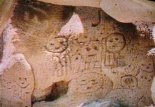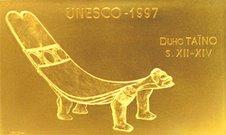To: Blue Water Ventures
Greetings,
I read with great interest the Internet article about your Margarita shipwreck pearl find. My wife, Rose Powhatan (Pamunkey/Tauxenent ), and I gave a lecture at the Natural History Museum of New York on Powhatan and Caribbean Pearls. I would like you to consider the following:
The pearls found in this shipwrecked galleon's site were probably from the Caribbean Peal Trade located in the pearl beds off the Venezuelan island of Margarita . The sunken ship had the appropriate name since it was from its namesake island's waters that the pearls (that came to rival the old Eastern pearl trade) were harvested.
Lucayan Taínos (conch divers from the Bahama Islands) were among the first unfortunate souls used in this deplorable enterprise that helped to deplete the Bahamas of its indigenous people and the Caribbean of its ancient pearl beds. Aside from pearls found in conchs, Spanish explorers may have first encountered Indigenous American pearl trade among the mainland peoples of South America .
Father Bartholomew de las Casas reported the horrible conditions of these divers, "who once looked like men but now appeared as deformed dogs", and who were forced to dive at very deep depths from canoes by their cruel Spanish masters. He reported that if a diver surfaced too early he was pushed underwater by his master in the canoe. At the pearl diver's campsites they suffered from the bends, unhealed sores, starvation and diseases so that European royalty, nobility and merchants could have the luxury of wearing clothes dripping with excessive amounts of Caribbean pearls (See paintings of European royalty of this period). The only "positive" story to have come out of the Caribbean Pearl trade was that of an enslaved Caribbean "Indian" who was given his freedom by his master for finding the largest famous pearl named "La Peregrina" or "The Orphan" (So named because the diver found the pearl out of its shell).
The current owner of the re-hung "La Peregrena" is actress Elizabeth Taylor who was given the pearl by her late husband actor Richard Burton. La Peregrina was briefly lost in her rug; her poodle appeared with it in its mouth. Maybe both the pearls found at the Margarita's site and La Peregrina should be donated to a museum for display that would also acknowledge the holocaust-like history of the Caribbean Pearl Trade, the first European slave trade in the Americas and of the brutal early enslavement of the indigenous peoples of the Caribbean.
One Love,
Michael Auld (Yamaye Taino descendant)
------------------------------
Thousands of pearls found in shipwreck
KEY WEST, Fla. - Salvagers discovered thousands of pearls Friday in a small, lead box they said they found while searching for the wreckage of the 17th-century Spanish galleon Santa Margarita. Divers from Blue Water Ventures of Key West said they found the sealed box, measuring 3.5 inches by 5.5 inches, along with a gold bar, eight gold chains and hundreds of other artifacts earlier this week.
They were apparently buried beneath the ocean floor in approximately 18 feet of water about 40 miles west of Key West.
"There are several thousand pearls starting from an eighth of an inch to three-quarters of an inch," said Duncan Mathewson, marine archaeologist and partner in Blue Water Ventures.
James Sinclair, archaeologist and conservator consulting with Mel Fisher's Treasures, Blue Water's joint-venture partners, said the pearls are very rare because of their antiquity and condition. Sinclair said pearls don't normally survive the ocean water once they are out of the oyster that makes them.
"In this instance, we had a lead box and the silt that had sifted into the box from the site of the Margarita, which preserved the pearls in a fairly pristine state," he said.
An initial cache of treasure and artifacts from the Santa Margarita was discovered in 1980 by pioneering shipwreck salvor Mel Fisher.
The ship was bound for Spain when it sank in a hurricane in 1622. The pearls will be conserved, documented and photographed in an archaeological laboratory above the Mel Fisher Maritime Museum in Key West.
"Until they're properly cleaned and conserved we don't know their value, but it would seem they would be worth upwards of a million dollars," Mathewson said.






















